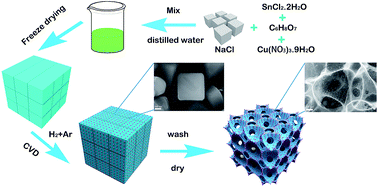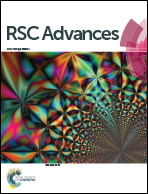Three-dimensional porous carbon nanosheet networks anchored with Cu6Sn5@carbon as a high-performance anode material for lithium ion batteries†
Abstract
The poor cycling stability resulting from large volume change is the major obstacle to the application of tin-based anode materials. In this paper, three-dimensional porous carbon nanosheet networks anchored with Cu6Sn5@carbon nanoparticles (10–35 nm) as a high-performance anode for lithium ion batteries are synthesized via a self-assembly NaCl template-assisted in situ chemical vapor deposition strategy. The composite exhibits superior rate capability (523, 443, 395, 327, 281, and 203 mA h g−1 at 0.2, 0.5, 1, 2, 5, and 10 A g−1, respectively) and excellent cycling stability (396.8 mA h g−1 at 1 A g−1 for the first cycle and maintains 92.3% after 200 cycles). The superior performance is attributed to the unique architecture: inactive metal copper serves as a “buffer matrix” and relaxes the large volume change of the tin; a uniform distribution of nano-sized Cu6Sn5 makes the inevitable stress/strain small, meanwhile it provides a short path for lithium ion diffusion; onion-like carbon shells not only prevent the Cu6Sn5 nanoparticles from agglomerating and growing but also offer mechanical support to accommodate the stress associated with the volume change of tin upon cycling, thus alleviating pulverization; 3D porous carbon nanosheet networks ensure the mechanical integrity and facilitate lithium ion diffusion as well as electron transportation.


 Please wait while we load your content...
Please wait while we load your content...